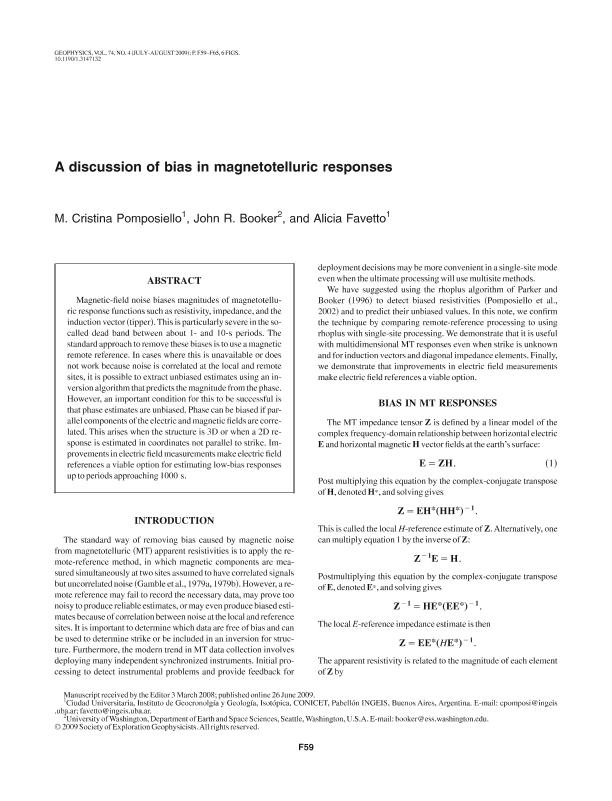Mostrar el registro sencillo del ítem
dc.contributor.author
Pomposiello, Maria Cristina

dc.contributor.author
Booker, John
dc.contributor.author
Favetto, Alicia Beatriz

dc.date.available
2017-07-17T16:32:37Z
dc.date.issued
2009-07
dc.identifier.citation
Pomposiello, Maria Cristina; Booker, John; Favetto, Alicia Beatriz; A discussion of bias in magnetotelluric responses; Society of Exploration Geophysicists; Geophysics; 74; 4; 7-2009; 59-65
dc.identifier.issn
0016-8033
dc.identifier.uri
http://hdl.handle.net/11336/20695
dc.description.abstract
Magnetic-field noise biases magnitudes of magnetotelluric response functions such as resistivity, impedance, and the induction vector (tipper). This is particularly severe in the so-called dead band between about 1- and 10-s periods. The standard approach to remove these biases is to use a magnetic remote reference. In cases where this is unavailable or does not work because noise is correlated at the local and remote sites, it is possible to extract unbiased estimates using an inversion algorithm that predicts the magnitude from the phase. However, an important condition for this to be successful is that phase estimates are unbiased. Phase can be biased if parallel components of the electric and magnetic fields are correlated. This arises when the structure is 3D or when a 2D response is estimated in coordinates not parallel to strike. Improvements in electric field measurements make electric field references a viable option for estimating low-bias responses up to periods approaching 1000 s.
dc.format
application/pdf
dc.language.iso
eng
dc.publisher
Society of Exploration Geophysicists

dc.rights
info:eu-repo/semantics/openAccess
dc.rights.uri
https://creativecommons.org/licenses/by-nc-sa/2.5/ar/
dc.subject
Geophysics
dc.subject
Magnetotelluric
dc.subject
Bias
dc.subject.classification
Geoquímica y Geofísica

dc.subject.classification
Ciencias de la Tierra y relacionadas con el Medio Ambiente

dc.subject.classification
CIENCIAS NATURALES Y EXACTAS

dc.title
A discussion of bias in magnetotelluric responses
dc.type
info:eu-repo/semantics/article
dc.type
info:ar-repo/semantics/artículo
dc.type
info:eu-repo/semantics/publishedVersion
dc.date.updated
2017-07-13T18:31:08Z
dc.identifier.eissn
1942-2156
dc.journal.volume
74
dc.journal.number
4
dc.journal.pagination
59-65
dc.journal.pais
Estados Unidos

dc.journal.ciudad
Tulsa
dc.conicet.avisoEditorial
© 2009 Society of Exploration Geophysicists. All rights reserved.
dc.description.fil
Fil: Pomposiello, Maria Cristina. Consejo Nacional de Investigaciones Científicas y Técnicas. Oficina de Coordinación Administrativa Ciudad Universitaria. Instituto de Geocronología y Geología Isotopica. Universidad de Buenos Aires. Facultad de Ciencias Exactas y Naturales. Instituto de Geocronología y Geología Isotópica; Argentina
dc.description.fil
Fil: Booker, John. University of Washington; Estados Unidos
dc.description.fil
Fil: Favetto, Alicia Beatriz. Consejo Nacional de Investigaciones Científicas y Técnicas. Oficina de Coordinación Administrativa Ciudad Universitaria. Instituto de Geocronología y Geología Isotopica. Universidad de Buenos Aires. Facultad de Ciencias Exactas y Naturales. Instituto de Geocronología y Geología Isotópica; Argentina
dc.journal.title
Geophysics

dc.relation.alternativeid
info:eu-repo/semantics/altIdentifier/doi/http://dx.doi.org/10.1190/1.3147132
dc.relation.alternativeid
info:eu-repo/semantics/altIdentifier/url/http://library.seg.org/doi/10.1190/1.3147132
dc.relation.alternativeid
info:eu-repo/semantics/altIdentifier/url/http://geophysics.geoscienceworld.org/content/74/4/F59
Archivos asociados
